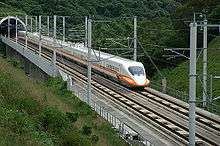North–South Express Railway (Vietnam)
| North–South Express Railway (Vietnam) | |
|---|---|
| Overview | |
| Status | Cancelled |
| Locale | Vietnam |
| Termini |
unknown unknown |
| Services | not available |
| Operation | |
| Operator(s) | Vietnam Railway Corporation |
| Technical | |
| Line length | 1,570 km (980 mi) |
| Track gauge | 1,435 mm (4 ft 8 1⁄2 in) |
| Operating speed | 350 km/h (220 mph) |
North-South Express Railway (Vietnamese: Đường sắt cao tốc Bắc-Nam) is a proposed express railway in Vietnam. The line would begin in Hanoi, crossing provinces and municipalities of Hanoi, Hà Tây, Hà Nam, Ninh Bình, Thanh Hóa, Nghệ An, Hà Tĩnh, Quảng Bình, Quảng Trị, Thừa Thiên-Huế, Đà Nẵng, Quảng Nam, Quảng Ngãi, Bình Định, Phú Yên, Khánh Hòa, Ninh Thuận, Bình Thuận, Đồng Nai, Bình Dương, and coming to an end in Ho Chi Minh City. The total proposed length would be 1,570 kilometres (980 mi), compared with the 1,729-kilometre (1,074 mi) of the old railway line.[1] The cost of the line is estimated at US$55.85 billion,[2] to be funded by official development assistance from Japan and by the Vietnamese government itself.
Overview

With preliminary topographical and geological surveillance already carried out by a joint Japanese-Vietnamese team, two sections of the railway—the 295-kilometre (183 mi) Hanoi–Vinh section and the 362-kilometre (225 mi) Ho Chi Minh City–Nha Trang section—were initially slated for implementation in stages between 2011 and 2015, with the implementation of the remaining Vinh–Nha Trang section starting in 2020. Japanese Shinkansen bullet train technology was proposed for use on this line; its technology—and its actual geographical track—would be completely independent of the existing North–South Railway line. The express line would be built as a double-track standard gauge (1,435 mm (4 ft 8 1⁄2 in)) line, with a design speed of 300 km/h (compared to an average of 50 kilometres per hour (31 mph) on the existing North–South Railway line). Once completed, passengers travelling between Hanoi and Ho Chi Minh City would see transit times reduced from 32 hours to around 7 hours.[3][4]
The Japanese government has, following the visit of Prime Minister Nguyễn Tấn Dũng to Japan in 2006, pledged to offer official development assistance for the project. The memorandum of understanding for the project (along with a related project, the North–South Expressway) was mutually signed by the two governments at that time.[5]
Project re-evaluation (2010)
On June 19, 2010, after a month of deliberations, Vietnam's National Assembly rejected the current high-speed rail proposal, reportedly due to the US$56 billion cost involved. National Assembly deputy Nguyễn Minh Thuyết reportedly stated that the proposed cost was equal to about 50 per cent of the country's gross domestic product, and that ordinary Vietnamese citizens would not be able to afford the high fares.[6] Senior economist Pham Chi Lan, who described the proposal as "economically unsound", noted that it would not serve the majority of Vietnamese citizens, 70 per cent of whom live in rural areas.[6] National Assembly members are said to have asked for further study of the project.[7] As late as August 2010, the Ministry of Transport confirmed that plans for the express railway were on hold pending further research.[8] At that time, Nguyen Huu Bang, the chairman and CEO of national railway company Vietnam Railways, stated that the government was expected to resubmit the project after new leaders of the Communist Party are selected in 2011, and that the Japan International Cooperation Agency (JICA) would likely be asked to examine the feasibility of two priority sections from Hanoi to Vinh and from Ho Chi Minh City to Nha Trang.[4] After a meeting with the Ministry of Transport in October 2010, Deputy Prime Minister Hoang Trung Hai was reported to have authorized the reception of Japanese technical assistance for those two sections.[8]
Shuji Eguchi, a director at the Japanese Transport Ministry's railway bureau, noted that the Japanese government has recently put more focus on exporting Japanese infrastructure systems such as the shinkansen to jump-start economic growth, but that the Vietnamese express railway project is considered a long-term one. In an August 2010 interview, Eguchi was quoted as saying "We need a step-by-step approach. The conventional Vietnamese railway is single track and not electrified yet ... To jump from that stage to the shinkansen, Vietnam needs to train personnel and enact necessary legislation."[4]
See also
- Transport in Vietnam
- Rail transport in Vietnam
- North–South Railway (Vietnam)
- North–South Expressway (Vietnam)
References
- ↑ Sơ sài dự án ngàn tỉ. Nguoi Lao Dong. May 12, 2010.
- ↑ "Sẽ có đường sắt cao tốc 300km/h Hà Nội - TP HCM". Dat Viet News. Retrieved December 30, 2009.
- ↑ "Rail boss: Vietnam to begin high-speed line in 2010". Deutsche Presse-Agentur. Monstersandcritics.com. 2007-10-23. Retrieved 7 January 2011.
- 1 2 3 Maya Kaneko (2010-08-28). "Held up Vietnam rail plan still counts on Japan". Kyodo News. The Japan Times. Retrieved 2010-11-01.
- ↑ "The visit to Japan successful: says PM Nguyen Tan Dung". Communist Party of Vietnam. 2006-10-22. Retrieved 2010-11-01.
- 1 2 "Vietnamese legislators reject $56B bullet train in rare move against Communist leaders". Metro News. Vancouver. Associated Press. 2010-06-21. Retrieved 2010-06-21.
- ↑ "National Assembly rejects express railway project". VietNamNet Bridge. 2010-06-21. Archived from the original on June 28, 2010. Retrieved 2010-06-21.
- 1 2 "Transport Ministry moves on with two express railways". 2010-10-30. Retrieved 2010-10-31.
- High-speed train planned for Vietnam. International Herald-Tribune. February 6, 2007.
- Vietnam to build high speed train. Reuters. February 6, 2007.